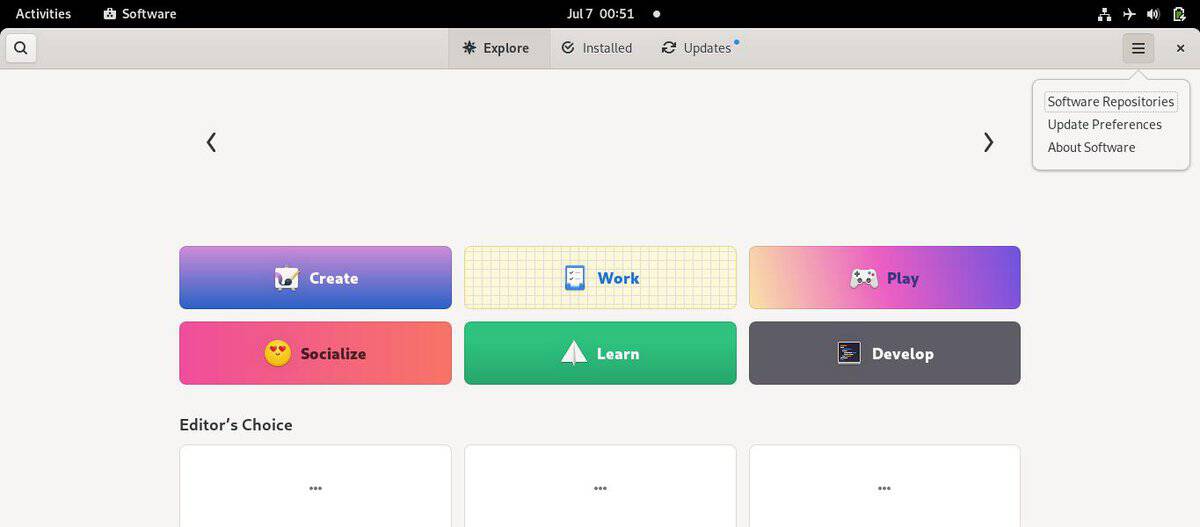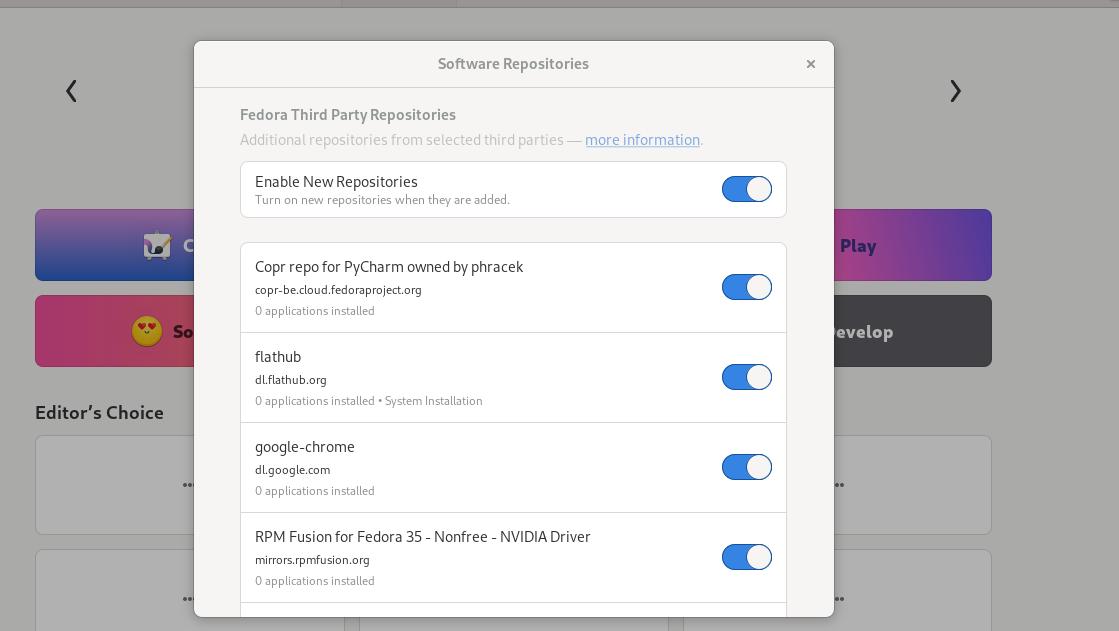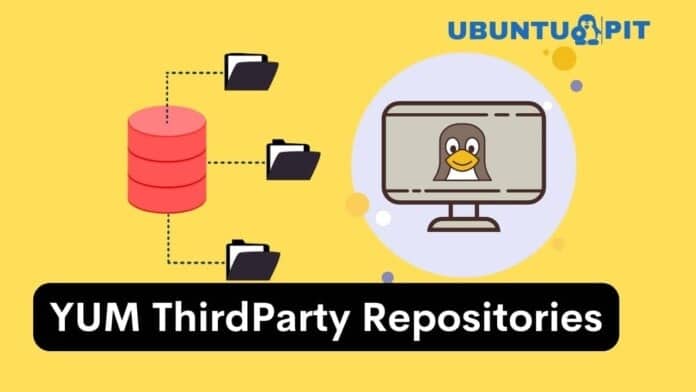Repositories are like huge servers where the developers store the application files. In Linux, the repositories play a vital role in app performance and installation. From my previous experiences, I’ve faced issues while installing applications due to a bad or broken repository. Most major Linux distributions have their own dedicated official Linux repository. Despite having their own dedicated repository for Fedora, CentOS, or Red Hat Linux, we might need to rely on some thirdparty YUM repositories for package installation via YUM commands.
YUM ThirdParty Repositories
The need for the YUM third-party repositories is seen when we need to install a package that is not yet available on the official repository or the package is too old that it’s no longer continued. Most of the thirdparty YUM repositories are free and open-source. There are many other reasons why you may need to use third-party repositories. You can get through the CLI methods.
There are some rules for getting the thirdparty repositories on Fedora, which you need to remember. If you’re trying to get a proprietary package, you might not get permission to get it on Fedora. You won’t also be able to get illegal packages on Fedora. If any package or dependency tool violates United States laws, you won’t be able to get it on your system.
In this post, we will see an overview of a few most used and common YUM ThirdParty Repositories for CentOS and RHEL; we will also see how you can get them into your system.
1. EPEL Repository
The EPEL is the most used and common third-party YUM repository for Red Hat and Fedora Linux. These YUM repositories can be used for both Red Hat, CentOS, and Fedora Linux. The full form of EPEL is defined as Extra Packages for Enterprise Linux. You can execute the below-mentioned yum commands with sudo access to get the EPEL repositories on your machine.

# yum install https://dl.fedoraproject.org/pub/epel/epel-release-latest-8.noarch.rpm # yum install https://dl.fedoraproject.org/pub/epel/epel-release-latest-7.noarch.rpm # yum install https://archives.fedoraproject.org/pub/archive/epel/6/x86_64/epel-release-6-8.noarch.rpm
2. REMI Repository
The REMI repository is another one of the best repositories for Red Hat Linux enterprise that can help PHP developers a lot. It supports Enterprise Linux (EL). It can be used for PHP stack, database integrations, and other developing tasks. You can get and enable the REMI third-party YUM repository by executing the below-mentioned YUM commands.
Enable REMI YUM repository On RHEL 8
# yum install https://dl.fedoraproject.org/pub/epel/epel-release-latest-8.noarch.rpm # yum install https://rpms.remirepo.net/enterprise/remi-release-8.rpm
Get REMI YUM repository On RHEL 7

# yum install https://dl.fedoraproject.org/pub/epel/epel-release-latest-7.noarch.rpm # yum install https://rpms.remirepo.net/enterprise/remi-release-7.rpm
Enable REMI YUM repository On RHEL 6
# yum install https://archives.fedoraproject.org/pub/archive/epel/6/x86_64/epel-release-6-8.noarch.rpm # yum install https://rpms.remirepo.net/enterprise/remi-release-6.rpm
3. RPMFusion Repository
The RPM fusion offers a huge source of packages for both Red Hat, CentOS, and Fedora Linux enterprises. You can get both free and paid packages through this thirdparty YUM repository. Using the RPMFusin is totally safe and secure. You can get and enable the RPMFusion repository on your Linux through the below-mentioned yum commands.
Enable RPMFusion YUM repository On RHEL 8
# yum install https://dl.fedoraproject.org/pub/epel/epel-release-latest-8.noarch.rpm # yum localinstall --nogpgcheck https://download1.rpmfusion.org/free/el/rpmfusion-free-release-8.noarch.rpm # yum localinstall --nogpgcheck https://download1.rpmfusion.org/nonfree/el/rpmfusion-nonfree-release-8.noarch.rpm
Get RPMFusion YUM repository On RHEL 7
# yum install https://dl.fedoraproject.org/pub/epel/epel-release-latest-7.noarch.rpm # yum localinstall --nogpgcheck https://download1.rpmfusion.org/free/el/rpmfusion-free-release-7.noarch.rpm # yum localinstall --nogpgcheck https://download1.rpmfusion.org/nonfree/el/rpmfusion-nonfree-release-7.noarch.rpm
Enable RPMFusion YUM repository On RHEL 6
# yum install https://archives.fedoraproject.org/pub/archive/epel/6/x86_64/epel-release-6-8.noarch.rpm # yum localinstall --nogpgcheck https://download1.rpmfusion.org/free/el/rpmfusion-free-release-6.noarch.rpm # yum localinstall --nogpgcheck https://download1.rpmfusion.org/nonfree/el/rpmfusion-nonfree-release-6.noarch.rpm
4. ELRepo Repository
The full form of the ELRepo is defined as the Enterprise Linux Repository. The ELRepo thirdparty repository is one of the best repositories for Red Hat, CentOS, and Fedora Linux that offers hardware-based softwares to make your computer more smooth. You can get your graphics card driver, sound audio card, web camera, keyboard, mouse driver, and other essential drivers from the ELRepo repositories.
You can get and enable the ELRepo Repository repository on your Linux through the below-mentioned yum commands.
Enable ELRepo YUM repository On RHEL 8
# rpm --import https://www.elrepo.org/RPM-GPG-KEY-elrepo.org # rpm -Uvh https://www.elrepo.org/elrepo-release-8.el8.elrepo.noarch.rpm
Get ELRepo YUM repository On RHEL 7
# rpm --import https://www.elrepo.org/RPM-GPG-KEY-elrepo.org # rpm -Uvh https://www.elrepo.org/elrepo-release-7.el7.elrepo.noarch.rpm
Enable ELRepo YUM repository On RHEL 6
# rpm --import https://www.elrepo.org/RPM-GPG-KEY-elrepo.org # rpm -Uvh https://www.elrepo.org/elrepo-release-6-8.el6.elrepo.noarch.rpm
5. NUX-dextop Repository
The NUX-dextop Repository for Linux offers multimedia packages for the enterprise Linux operating systems. You can get your multimedia player and multimedia codec packages from the NUX-dextop thirdparty YUM repository.
You can get and enable the NUX-dextop Repository on your Linux through the below-mentioned yum commands.
Enable NUX-dextop YUM repository On RHEL 8
# yum install https://dl.fedoraproject.org/pub/epel/epel-release-latest-8.noarch.rpm # yum install https://li.nux.ro/download/nux/dextop/el7/x86_64/nux-dextop-release-0-5.el7.nux.noarch.rpm
Get NUX-dextop YUM repository On RHEL 7
# yum install https://dl.fedoraproject.org/pub/epel/epel-release-latest-7.noarch.rpm # yum install https://li.nux.ro/download/nux/dextop/el7/x86_64/nux-dextop-release-0-5.el7.nux.noarch.rpm
Enable NUX-dextop YUM repository On RHEL 6
# yum install https://archives.fedoraproject.org/pub/archive/epel/6/x86_64/epel-release-6-8.noarch.rpm # yum install https://li.nux.ro/download/nux/dextop/el6/x86_64/nux-dextop-release-0-2.el6.nux.noarch.rpm
6. GhettoForge YUM ThirdParty Repository
The GhettoForge thirdparty YUM repository was built for enterprise Linux systems like Red Hat Linux Enterprise. On this repository, we will find postfix, limnoria, and other essential packages. You won’t find packages on this repository for the older versions of RHELs.
You can get and enable the GhettoForge thirdparty YUM Repository on your Linux through the below-mentioned yum commands.
Enable GhettoForge YUM repository On RHEL 8
# yum install https://mirror.ghettoforge.org/distributions/gf/gf-release-latest.gf.el8.noarch.rpm
Get GhettoForge YUM repository On RHEL 7
# yum install https://mirror.ghettoforge.org/distributions/gf/gf-release-latest.gf.el7.noarch.rpm
Enable GhettoForge YUM repository On RHEL 6
# yum install https://mirror.ghettoforge.org/distributions/gf/gf-release-latest.gf.el6.noarch.rpm
7. Psychotic Ninja YUM Repository
The Psychotic Ninja thirdparty YUM Repository offers the users good quality and authentic packages that are not available in the conventional enterprise Linux repository. You will find the GNU package key on this repository.
To import the GPG key and enable the Psychotic Ninja Repository on your Linux through the below-mentioned yum commands.

# rpm --import https://wiki.psychotic.ninja/RPM-GPG-KEY-psychotic # rpm -ivh https://packages.psychotic.ninja/6/base/i386/RPMS/psychotic-release-1.0.0-1.el6.psychotic.noarch.rpm
8. IUS Community YUM ThirdParty Repository
The IUS is the short form of Inline with Upstream Stable, which is a community-based thirdparty YUM repository for Red Hat, CentOS, and Fedora Linux. You will get packages for PHP frameworks, Python Pips, SQL, and other packages.
To enable the IUS Community Repository on your Linux through the below-mentioned yum commands.
# yum install https://dl.fedoraproject.org/pub/epel/epel-release-latest-7.noarch.rpm # yum install https://repo.ius.io/ius-release-el7.rpm
Extra Tip: GUI ThirdParty Repositories on Gnome Fedora
So far, we have seen how to get third-party YUM repositories via the CLI method. Here, we will discuss the GUI method to enable the thirdparty repositories. You will find this option in GNOME-based Fedora Linux and systems as well.
First, you will need to go to the software and package application for your software section. Now, browse the three-bar menu from the top-right corner, as you can see in the below image.

Now, click on the Software Repositories. Then you’ll see the option to install the Thirdparty repositories on your YUM-based system.

Insights!
In the entire post, we have seen the overview of a few most common and active YUM thirdparty repositories and the methods of getting them into your Linux machine. We have also seen how you can enable the default thirdparty repository on Fedora through the GUI method. Please note that if you fail to load any repository on your system, please tweak your default repository server location and try again.
I hope this post has been helpful for you; if yes, please share this post with your friends and the Linux community. You can also write down your opinions about this post in the comment section.
